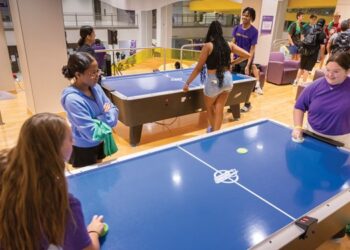Thousands of students across the country use the facilities and equipment at campus rec centers daily.
To make sure these hubs of health and fitness continue to provide their invaluable services, collegiate facility managers lead teams of workers in daily tasks and facility upkeep.
Dustin Soderman, the associate director of facilities and operations at Arizona State University (ASU), has been at the university for almost seven years and works daily to better the lives of students and staff. With an enrollment of over 50,000 undergraduate students, that is a tall task.
However, he said all those voices can help facility management.
“The size of our student body creates a very diverse student body,” said Soderman. “One size does not fit all. At a larger institution, you must be willing to listen to your student users. Our programs need to change with our class sizes. We need to be able to meet these needs and create places students want to come back to over and over again.”
One key personality trait he said is necessary in communicating with students and staff is humility.
Every day, Soderman takes multiple routine walks around ASU’s facilities. He does so to not only to see what needs attention but to speak directly with individuals.
He also implemented an open-door office policy. This establishes a clear path of personal communication between himself and other Sun Devils.
“Oftentimes the best answers I’ve found in my career came through talking with students,” said Soderman. “Knowing you work together as a team will pay dividends time and time again. Facilities touch everybody in some shape or form. Our impact is on all those programs, but they can’t be successful if we can’t share what’s going on.”
EXTRA CREDIT: ECU Campus Rec recently adopted the school’s Athletics branding, and the department has seen a positive response from students.
One piece of advice Soderman had for maintaining campus rec centers specifically pertains to securing bids with vendors for projects.
He said it’s critical to secure multiple bids on maintenance projects regardless of how secure or reliable a specific vendor bid may seem.
“Sometimes, your normal person will get a backlog or have a supply chain issue where they cannot fulfill your need at that time,” said Soderman. “Multiple bids may also provide you with a cheaper expense as well. My No. 1 lesson is to be flexible and adaptable.”
One vendor Soderman says he has success with is Ecore Flooring.
“We’ve worked with Ecore on a number of projects surrounding flooring for weight rooms, cardio areas and synthetic turf,” said Soderman. “Their communication from initial call to concept, install and follow up post-install has been great. Any issues have been taken care of through the warranty process in a timely manner. Their products have matched directly with our vision on creating spaces that increase affinity toward ASU.”
But perhaps even more important in the purchase process is the relationship established between facility staff and custodial services.
He said involve the people who are directly caring for recreational spaces in this process. That’s the way to ensure facility upkeep is successful.
EXTRA CREDIT: What’s more important: quality products or quality vendor partners?
“Everything looks great the second you install it, but they are the ones who will be ensuring its longevity,” said Soderman. “Having their input and support from Day One is so important. What they manage on a day-to-day schedule is crucial.”
Blake Simpfenderfer, the associate director of Campus Recreation Operations at the University of Vermont (UVM), echoed similar advice concerning relations with custodial staff.
He said after a few years of renovations to the campus rec facilities at UVM, they had a rocky start due to some misunderstandings between the staff teams.
“I’ve found with our custodial department that ensuring you are on the same page is critical,” said Simpfenderfer. “After we ironed out expectations and responsibilities, everything is being properly cleaned. We are now receiving compliments on how nice the spaces look.”
Different campuses have different challenges and thus require different solutions. For example, a major area of focus for ASU is caring for a huge student body. However, UVM’s enrollment is around a quarter of that size.
Simpfenderfer said UVM’s facility was constructed at different times throughout the past, creating uncommon difficulties.
“It makes for a lot of unique challenges in terms of keeping different systems functioning and ensuring a cohesive look throughout the complex,” he said. “Flexibility is key. We have an older facility. We’ve learned to always come into your day being flexible and having the ability to react to the problem of the day.”
Brian McGuire, the buildings and grounds superintendent at the University of Wisconsin-Madison (UW-Madison), said one strategy in caring for older facilities is by sharing the workload with your staff.
“An example I have done is having my grounds crew who have a lighter workload in the winter months assist the inside maintenance staff with their workload,” said McGuire. “Get to know your team and the skills, special talents, and interests they have to offer. Match their work assignments with those talents.”
EXTRA CREDIT: Stan Shingles at Central Michigan University explains how facility updates must include planning and expert advice.
When it comes to the gritty work completed by staff, McGuire said it was paramount for them to have the best possible tools and resources needed to do their jobs.
He added such resources include making sure those employees receive fair compensation for the work they perform.
For tools, McGuire said they use as much Milwaukee brand battery-powered equipment as possible:
- Drills
- Drivers
- Impacts
- Saws
- Vacuum cleaners
- Flashlights
- Inspection camera
- And more
“By using the same brand, the batteries interchange, and it is a cost and time saver,” said McGuire. “For our grounds department, we are looking to the future of battery-powered lawn mowers, string trimmers, leaf blowers and utility vehicles all soon to be added.”
Preventative maintenance on equipment and tools, the use of a strong work order program and periodic facility shutdowns are strategies McGuire also said are very helpful. “We do a couple shut down weeks a year in order to deep clean and repair our facilities,” he said. “This includes cleaning and moving all the fitness equipment, cleaning floors, hardwood refinishing, carpet cleaning, window washing, and dusting duct work in the gyms. This also allows us to get into areas like the woman’s locker room to perform any needed repairs.”
But possibly the simplest advice McGuire had is to give positive feedback to coworkers when possible. “Facility professionals take pride in a job well done and the skills they have acquired,” he said. “Take a moment and when the opportunity comes around, talk to them and give them praise. The staff will appreciate it and you may learn something new.”










